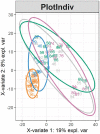Non-Targeted Metabolomic Analysis Reveals Serum Phospholipid Alterations in Patients with Early Stages of Diabetic Foot Ulcer
- PMID: 32952396
- PMCID: PMC7485163
- DOI: 10.1177/1177271920954828
Non-Targeted Metabolomic Analysis Reveals Serum Phospholipid Alterations in Patients with Early Stages of Diabetic Foot Ulcer
Abstract
Diabetic foot ulcer (DFU) is a common complication of type 2 diabetes mellitus (T2DM) characterized by ulcer formation, which can lead to the amputation of lower extremities. However, the metabolic alterations related to this complication are not completely elucidated. Therefore, we carried out a metabolomic analysis of serum samples obtained from T2DM adult patients diagnosed with diabetic foot ulcer in a cross-sectional, observational, and comparative study. Eighty-four volunteers were classified into the following groups: without T2DM (control group, n = 30) and with T2DM and different stages of diabetic foot ulcer according to Wagner-Meggitt classification system: DFU G0 (n = 11), DFU G1 (n = 14), DFU G2 (n = 16), and DFU G3 (n = 13). The non-target metabolomic profile followed by chemometric analysis revealed that lysophosphatidylethanolamine (16:1) could be proposed as key metabolite related to the onset of diabetic foot ulcer; however, this phospholipid was not affected by diabetic foot ulcer progression. Therefore, further studies are necessary to validate these phospholipids as biomarker candidates for the early diagnosis of diabetic foot ulcer in T2DM patients.
Keywords: Diabetic foot ulcer; mass spectrometry; metabolomic analysis; phospholipids; type 2 diabetes mellitus.
© The Author(s) 2020.
Conflict of interest statement
Declaration of conflicting interests:The author(s) declared no potential conflicts of interest with respect to the research, authorship, and/or publication of this article.
Figures



Similar articles
-
Level of 25-hydroxyvitamin D and vitamin D receptor in diabetic foot ulcer and factor associated with diabetic foot ulcers.Diabetol Metab Syndr. 2023 Feb 24;15(1):30. doi: 10.1186/s13098-023-01002-3. Diabetol Metab Syndr. 2023. PMID: 36829206 Free PMC article.
-
Correlation between the platelet-to-lymphocyte ratio and diabetic foot ulcer in patients with type 2 diabetes mellitus.J Clin Lab Anal. 2021 Apr;35(4):e23719. doi: 10.1002/jcla.23719. Epub 2021 Jan 28. J Clin Lab Anal. 2021. PMID: 33507619 Free PMC article.
-
Neutrophil Extracellular Traps (NETs) Are Associated with Type 2 Diabetes and Diabetic Foot Ulcer Related Amputation: A Prospective Cohort Study.Diabetes Ther. 2024 Jun;15(6):1333-1348. doi: 10.1007/s13300-024-01579-6. Epub 2024 Apr 15. Diabetes Ther. 2024. PMID: 38619692 Free PMC article.
-
Factors Related to Severity of Diabetic Foot Ulcer: A Systematic Review.Diabetes Metab Syndr Obes. 2020 May 25;13:1835-1842. doi: 10.2147/DMSO.S256243. eCollection 2020. Diabetes Metab Syndr Obes. 2020. PMID: 32547145 Free PMC article. Review.
-
Literature review on the management of diabetic foot ulcer.World J Diabetes. 2015 Feb 15;6(1):37-53. doi: 10.4239/wjd.v6.i1.37. World J Diabetes. 2015. PMID: 25685277 Free PMC article. Review.
Cited by
-
The prognostic and diagnostic significance of inflammatory markers TNF-α, IL-6, and IFN-γ in evaluating disease severity in diabetic foot infection.Front Cell Infect Microbiol. 2025 Jul 3;15:1606612. doi: 10.3389/fcimb.2025.1606612. eCollection 2025. Front Cell Infect Microbiol. 2025. PMID: 40677522 Free PMC article.
-
[Research advances of various omics analyses in chronic refractory wounds on body surface].Zhonghua Shao Shang Yu Chuang Mian Xiu Fu Za Zhi. 2023 Jan 20;39(1):75-80. doi: 10.3760/cma.j.cn501225-20220216-00030. Zhonghua Shao Shang Yu Chuang Mian Xiu Fu Za Zhi. 2023. PMID: 36740430 Free PMC article. Review. Chinese.
-
Lipidomics Characterization of the Microbiome in People with Diabetic Foot Infection Using MALDI-TOF MS.Anal Chem. 2023 Nov 7;95(44):16251-16262. doi: 10.1021/acs.analchem.3c03071. Epub 2023 Oct 25. Anal Chem. 2023. PMID: 37877781 Free PMC article.
-
Integrating Data Mining with Metabolomics to Analyze the Mechanism of the "Pearl-Borneol" Pair in Promoting Healing of Diabetic Wounds.Endocr Metab Immune Disord Drug Targets. 2025;25(1):66-79. doi: 10.2174/0118715303295707240614060314. Endocr Metab Immune Disord Drug Targets. 2025. PMID: 38994612
-
Multiomics Analysis Unravels Alteration in Molecule and Pathways Involved in Nondiabetic Chronic Wounds.ACS Omega. 2024 Apr 25;9(18):20425-20436. doi: 10.1021/acsomega.4c01335. eCollection 2024 May 7. ACS Omega. 2024. PMID: 38737053 Free PMC article.
References
-
- Davis FM, Kimball A, Boniakowski A, Gallagher K. Dysfunctional wound healing in diabetic foot ulcers: new crossroads. Curr Diabetes Rep. 2018;18:2. - PubMed
-
- Ahmad J. The diabetic foot. Diabetes Metab Syndr Clin Res Rev. 2016;10:48-60. - PubMed
-
- Veves A, Giurini JM, Guzman RJ. The Diabetic Foot: Medical and Surgical Management. 4th ed. New Jersey: Humana Press, Springer International Publishing AG; 2018.
-
- Pichu S, Patel BM, Apparsundaram S, Goyal RK. Role of biomarkers in predicting diabetes complications with special reference to diabetic foot ulcers. Biomark Med. 2017;11:377-388. - PubMed
LinkOut - more resources
Full Text Sources

